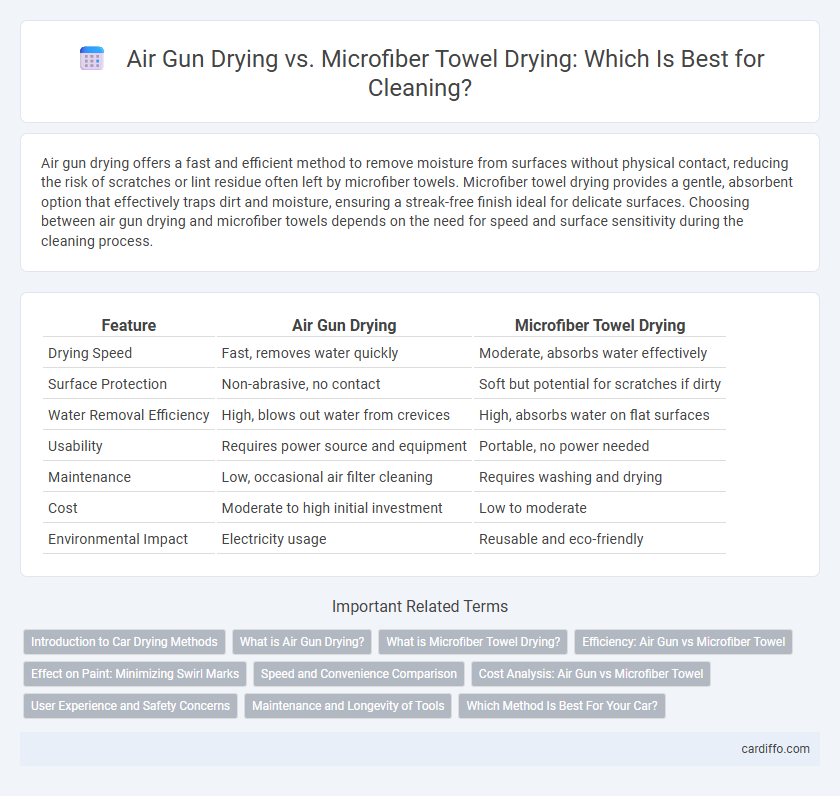Air gun drying offers a fast and efficient method to remove moisture from surfaces without physical contact, reducing the risk of scratches or lint residue often left by microfiber towels. Microfiber towel drying provides a gentle, absorbent option that effectively traps dirt and moisture, ensuring a streak-free finish ideal for delicate surfaces. Choosing between air gun drying and microfiber towels depends on the need for speed and surface sensitivity during the cleaning process.
Table of Comparison
| Feature | Air Gun Drying | Microfiber Towel Drying |
|---|---|---|
| Drying Speed | Fast, removes water quickly | Moderate, absorbs water effectively |
| Surface Protection | Non-abrasive, no contact | Soft but potential for scratches if dirty |
| Water Removal Efficiency | High, blows out water from crevices | High, absorbs water on flat surfaces |
| Usability | Requires power source and equipment | Portable, no power needed |
| Maintenance | Low, occasional air filter cleaning | Requires washing and drying |
| Cost | Moderate to high initial investment | Low to moderate |
| Environmental Impact | Electricity usage | Reusable and eco-friendly |
Introduction to Car Drying Methods
Air gun drying utilizes high-velocity compressed air to efficiently remove water from a car's surface, minimizing the risk of water spots and physical contact that could cause scratches. Microfiber towel drying relies on ultra-soft, highly absorbent fibers designed to trap moisture and debris while gently drying the surface. Both methods aim to preserve vehicle paint integrity and achieve a spotless finish, with air gun drying excelling in speed and microfiber towels offering tactile control.
What is Air Gun Drying?
Air gun drying uses compressed air to rapidly remove water from surfaces, ensuring a streak-free and dust-free finish ideal for automotive and electronic cleaning. This method minimizes physical contact, reducing the risk of scratches compared to microfiber towel drying, which relies on manual wiping to absorb moisture. Air gun drying is especially effective for hard-to-reach areas and delicate surfaces where lint or fibers from towels could cause damage.
What is Microfiber Towel Drying?
Microfiber towel drying is a cleaning method that uses densely woven synthetic fibers to efficiently absorb water and remove dirt from surfaces. This technique reduces the risk of scratches and streaks often caused by traditional drying materials, making it ideal for delicate finishes. Compared to air gun drying, microfiber towels provide immediate moisture removal, promoting faster drying times and preventing water spots.
Efficiency: Air Gun vs Microfiber Towel
Air gun drying offers rapid moisture removal by utilizing high-velocity air, significantly reducing drying time compared to microfiber towels. Microfiber towel drying absorbs water effectively but requires manual effort and longer contact time for thorough drying. Efficiency in drying depends on the volume of surface area and accessibility, with air guns excelling in industrial or large-scale applications while microfiber towels remain practical for detail-oriented, delicate surfaces.
Effect on Paint: Minimizing Swirl Marks
Air gun drying minimizes swirl marks on paint by quickly blowing off water without physical contact, reducing the risk of abrasive scratches. Microfiber towel drying can also protect the paint surface by gently absorbing water, but improper technique or low-quality towels may cause fine swirl marks. Optimal paint care involves selecting tools that reduce friction and avoid trapping debris, preserving the paint's smooth, glossy finish.
Speed and Convenience Comparison
Air gun drying offers rapid drying speeds by using high-velocity air to quickly remove moisture from surfaces, significantly reducing overall drying time compared to microfiber towel drying. Microfiber towels provide convenient, graspable drying with minimal equipment but require more manual effort and time to achieve a fully dry surface. For high-volume or time-sensitive cleaning tasks, air gun drying maximizes efficiency, whereas microfiber towels offer portability and control for detailed, smaller jobs.
Cost Analysis: Air Gun vs Microfiber Towel
Air gun drying generally involves higher initial equipment costs and increased energy consumption compared to microfiber towel drying, which requires minimal upfront investment and negligible energy use. Over time, microfiber towels prove more cost-effective due to their reusability, low replacement frequency, and limited maintenance expenses, while air guns demand ongoing electricity costs and potential repair fees. Businesses aiming for budget-friendly cleaning solutions often favor microfiber towels for their long-term economic advantages in both small-scale and industrial settings.
User Experience and Safety Concerns
Air gun drying provides a fast, touch-free method that reduces contact with surfaces, minimizing the risk of spreading bacteria and improving hygiene during cleaning tasks. Microfiber towel drying offers superior absorbency and gentle surface contact, reducing the likelihood of scratches while effectively removing moisture and debris. Safety concerns with air guns include potential eye irritation and noise exposure, whereas microfiber towels pose minimal safety risks but require proper cleaning to prevent bacterial buildup.
Maintenance and Longevity of Tools
Air gun drying minimizes moisture retention, preventing rust and corrosion in cleaning tools, thereby extending their lifespan. Microfiber towel drying effectively removes residual water and debris, reducing the risk of tool surface damage and maintaining optimal performance over time. Regular use of air gun drying combined with microfiber towels ensures thorough maintenance, enhancing the durability and longevity of cleaning equipment.
Which Method Is Best For Your Car?
Air gun drying offers rapid moisture removal with minimal contact, reducing the risk of scratches and water spots on your car's surface, while microfiber towel drying provides a gentle, absorbent method that can effectively capture dirt and prevent swirl marks if used properly. For maintaining paint integrity, air gun drying is ideal for detailers seeking efficiency and scratch-free results, whereas microfiber towels excel in accessibility and versatility for regular at-home car care. Choosing the best method depends on your car's finish, drying speed preferences, and whether you prioritize scratch prevention or thorough cleaning ability.
Air gun drying vs Microfiber towel drying Infographic

 cardiffo.com
cardiffo.com